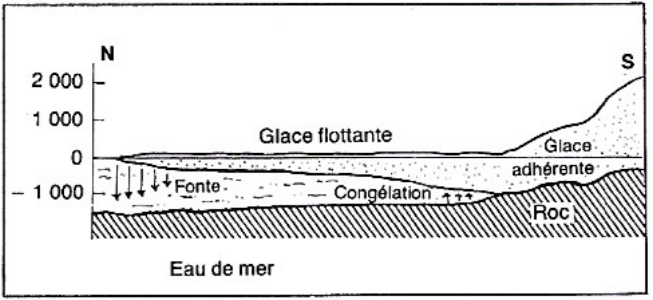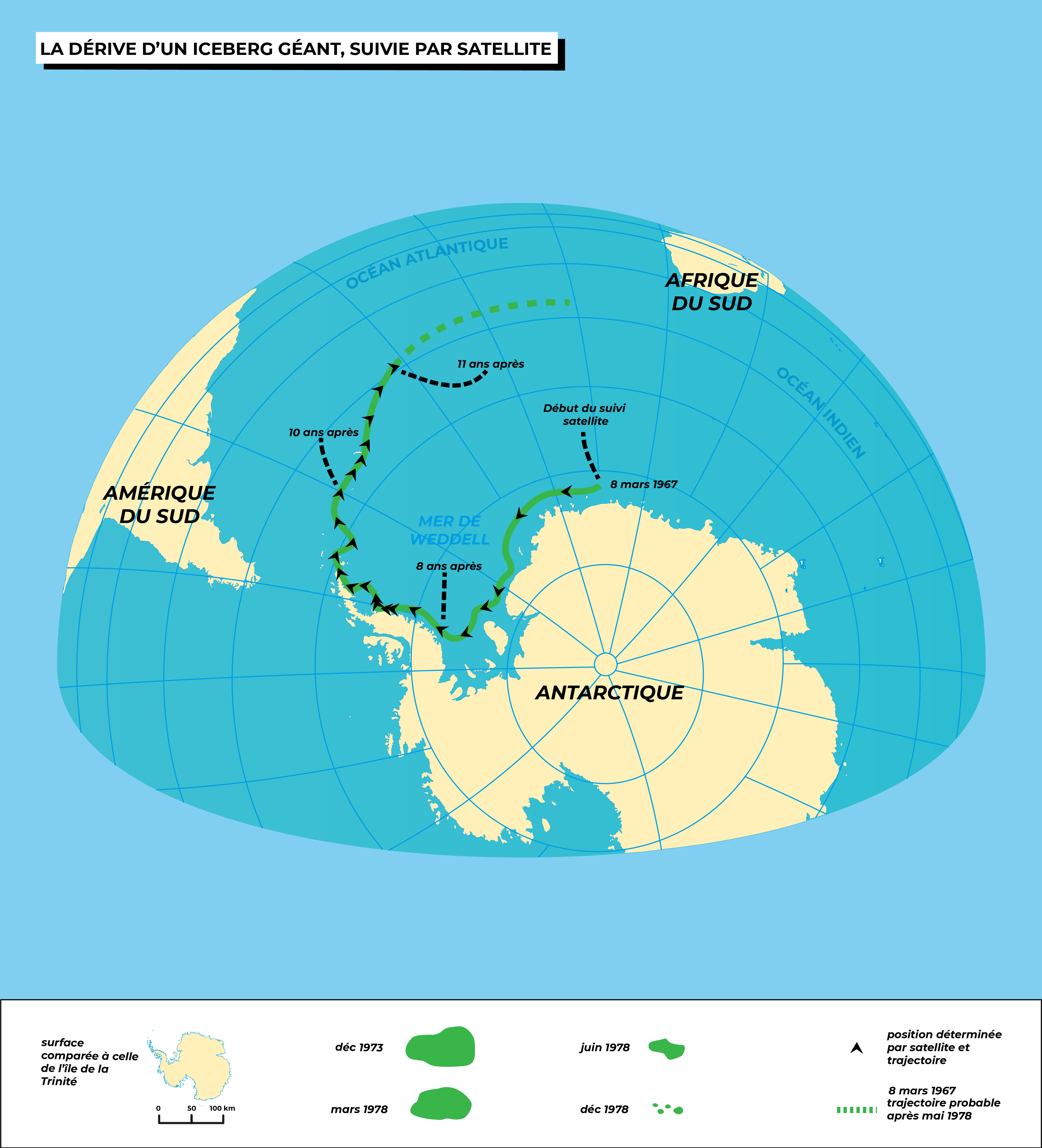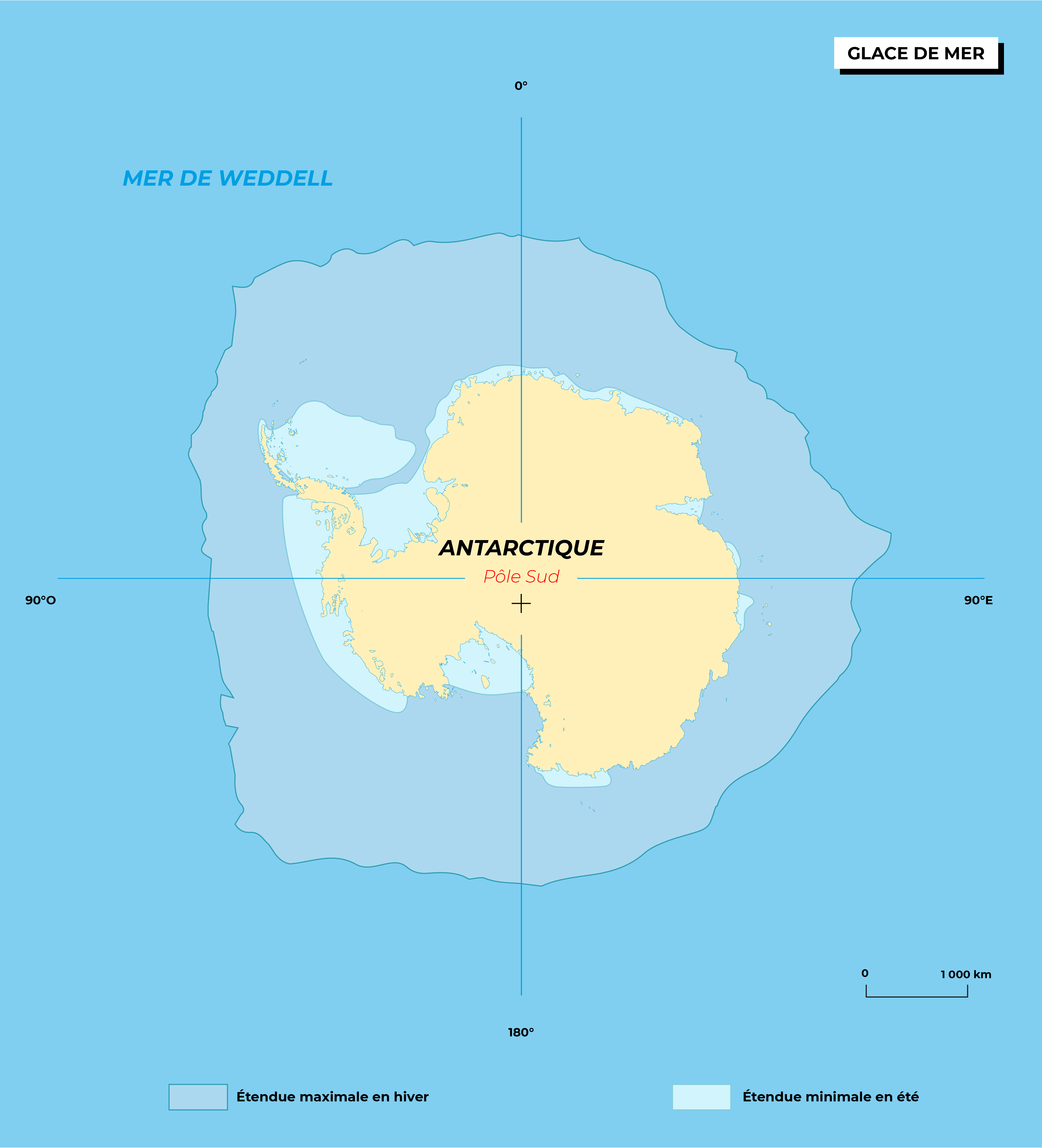Polar Encyclopædia
ICES OF THE OCEAN

Floating in the Southern Ocean, the Polar POD will have to zigzag between icebergs of all sizes. Around him, especially in winter, it is the frozen crust of the pack ice that will flirt with his hull, increasingly thick and solid as he approaches Antarctica with here and there a crabeater seal to keep him company.

Coupe d'une plate-forme de glace flottante.
What you should know :
Ice shelves are not formed at sea, but are floating extensions of the continental cap. The most important ones are those of the Ross and Weddell seas; others are also important, like the Amery ice shelf in the east, the Larsen ice shelf along the east coast of the peninsula or the Fimbul ice shelf in the north. All these floating ice areas are fed by the glaciers that flow from the cap. Thanks to Archimedes' thrust, the thick layer floats above the sea floor. The zones where the frozen "flow" is deformed by an obstacle (island, cape) as well as the junction with the land, or hinge, are intensely cracked and particularly dangerous during raids; from the front of the platform, which ends in a cliff that is usually inaccessible (or barrier), huge pieces break off with a bang and drift away. The thickness of the floating ice shelves is about 500 m, which prevents them from melting during the summer and makes them permanent. On May 19, 2021, a huge 4,320 km2 iceberg, newly named A-76, broke off from the Ronne Ice Shelf in Antarctica. It thus becomes "the largest iceberg in the world". These titanic calvings change the design of accessible coasts (the Bay of Whales, from where Amundsen left for the Pole has disappeared), and even take away drifting bases (like Belgrano or Drouznhaya in 1986).

The drift of a giant iceberg, tracked by satellite.
Icebergs are pieces of land ice detached from coastal cliffs, glaciers or platforms. These last fragments are tabular and sometimes immense: their progression can be followed by satellite. They are first carried away by eastern currents, then move in the opposite direction north of the divergence; their course (about 10 km per day) is also influenced by winds (sail effect) and possible drifting. Whatever their size, barely 1/10 of the mass of these "ice mountains" emerge above the waves. The largest tabular iceberg was reported in 1956: it measured 395 km long and 95 wide!

The annual "pulsation" of the pack ice.
The ice pack is a layer of ice formed at sea. The salt water of the ocean freezes at a temperature of 1.8°C. A multitude of crystals begin to form in the fall, soon covering the sea with an oily-looking "skin" called frazil ice. Then some kind of ice lilies, or pancakes, appear, enlarged and broken several times by the wind and the waves; the pieces gathered by the ocean and reassembled unceasingly are intertwined at the coast in an inextricable chaos difficult to cross. In the open sea, the pancakes end up becoming joined: the ice pack is then formed. It extends and consolidates until the heart of winter, keeping however a certain mobility because of open water zones, or polynyas (ice free zones of pack ice formed by upwelling of warmer water or fracturing by the wind), trapped here and there. The thickness of the pack ice varies from 1 to 3 meters but, due to the effect of the wind, two patches of 3 meters can overlap. When two plates of pack ice collide, they can form a small mountain that the Inuit and navigators call "hummock". Finally, pack ice is much more subject to winds than icebergs because of its rough surface. The ice being made of fresh water, pockets of over salted brine are locked in the frozen oceanic crust, from where they slowly migrate outwards. Only icebreakers can break through the pack ice, which doubles the surface of the southern polar ice at the winter maximum, bringing the "coast" up to 600 km from the continental shore in the east and up to 3,000 km in the Weddell Sea.
Suggested activities
The ice of the ocean
- During the formation of the ice pack, what are the modifications of the underlying water? What are the oceanographic consequences? And for the climate?
- What would be the impact of the melting of the ice pack on the rise in sea level? And what about the Antarctic ice cap?
For more details
Books :
- Glaces de l’Antarctique - C. Lorius.
- L’Antarctique, désert de glace – C. Lorius
- La Voix des pôles - L. Lescarmontier.
- Salut au grand Sud – I. Autissier & E. Orsenna.
Support the project with a donation
The Polar POD expedition is one of the stamp of the pioners, a human adventure coupled with a technological challenge, an oceanographic exploration never before carried out which will mark a milestone in the discovery of the oceans.
Thank you for your support !